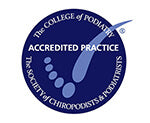What is a biomechanical assessment, and how can it help you?

Are you experiencing pain in your lower limbs? Sometimes it can be tricky to know the root cause of aches and twinges. And without knowing the cause, it can be even trickier to find the appropriate treatment.
If you have unexplained foot pain, ankle pain, knee pain, or even back pain, you could benefit from a biomechanical assessment. But what do these assessments entail?
What is a biomechanics assessment?
Podiatric biomechanics is the study of the lower limbs and looks at the structure, alignment, and function of the feet and legs. Biomechanical assessments investigate a patient’s lower limb function.
Have you ever noticed the development of pain in the lower limbs with no discernible cause? It could stem from the way you stand, walk, or run. Any abnormalities mean the body has to compensate for the anomalies, putting muscles, ligaments, joints, and tendons under strain. What’s more, repetitive daily motions, such as walking can impact more than just the feet. It can place strain on your legs, pelvis, and spine, too, causing discomfort in your ankles, knees, and back.
A biomechanical podiatrist will look closely for any abnormalities and compensations that may be causing pain or discomfort in any of these areas.
By working out what may be causing the issue, your podiatrist will then be able to recommend the best course of treatment.
What happens during a biomechanical assessment?
A biomechanical analysis usually entails several observations and examinations. The appointment will usually take up to 45 minutes, so it’s important to make sure you can be at the clinic for that length of time.
During an assessment at City Foot Health, our podiatrists will:
- Carefully observe and measure your range of motion through the joints in the lower limbs.
- Test your muscle strength.
- Examine your Foot Posture Index (FPI) to explore your standing posture.
- Look at your foot and lower limb flexibility.
- Look for any misalignments in the feet, legs, pelvis and shoulders.
- Explore forces and pressure on your feet.
We will also assess the way you stand and walk, taking into consideration your footwear and lifestyle in general. We recommend that you bring along a couple of pairs of shoes that you wear regularly so we can get an accurate picture of the foot support you have on a daily basis.
Gait analysis
As part of the biomechanical assessment, we use video gait analysis to obtain the most accurate diagnosis of the way you walk and run. This is achieved by recording your range of motion on a treadmill or across the floor, while you perform different walking paces. We’ll assess how you run, too.
The analysis enables us to detect the contact and flight times of your normal gait cycle and diagnose some of the most complex gait abnormalities. Abnormal gait can be caused by injury or illness but may also be due to a range of genetic factors or abnormalities in the feet and legs. It’s important to know the root of the gait abnormality so we can take action to reduce your pain or discomfort.
Once we have identified the causes of your problems, we can develop a tailor-made treatment plan to improve your symptoms. This may involve one or more of the following:
- Exercises to stretch or strengthen the muscles in your feet and legs.
- Orthoses – these are specially made devices for you to wear inside your shoe. They help control, realign or cushion the abnormalities.
What are orthoses?
Foot orthoses (or orthotics), are specially designed shoe inserts that help support the feet and improve foot posture. They fit comfortably into your shoes and are a pain-free solution for improving the way your feet function.
We may prescribe orthotics to help with an array of biomechanical foot disorders, including high arches, pronation (flat feet), bunions, arch pain, Morton’s neuromas and Plantar Fasciitis (heel pain).
The aim of orthotics is to correct dysfunctional biomechanics. By doing so, they can:
- Reduce pain
- Provide support and better positioning to the lower limb
- Prevent or stop the development of foot deformity
- Relieve pressure on specific areas of the foot
- Improve overall biomechanical function
- Improve alignment of the lower limb
- Reduce lower limb torsion and stress
For example, orthotics can help with structural conditions such as forefoot varus and rear foot varus. In both cases, misalignment can lead to ankle strain. However, orthotic devices, such as forefoot or heel wedges can help realign the joints, reducing the need for compensation.
Why do I need an assessment?
A biomechanical assessment is the best way to identify the cause of lower limb pain. Getting an assessment early on can help prevent your symptoms from worsening.
You may also wish to see a biomechanical podiatrist if you’d like to explore your walking pattern to ensure you’re not putting excess strain on certain joints or muscles. This can help reduce the chance of pain and discomfort developing in the future.


